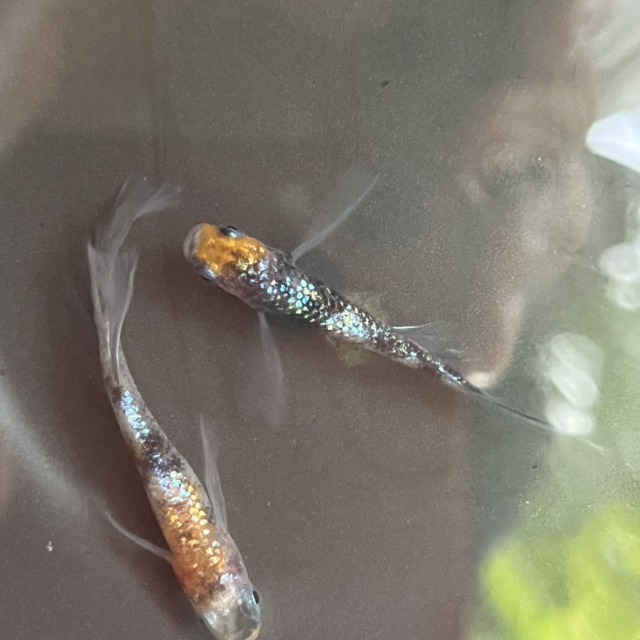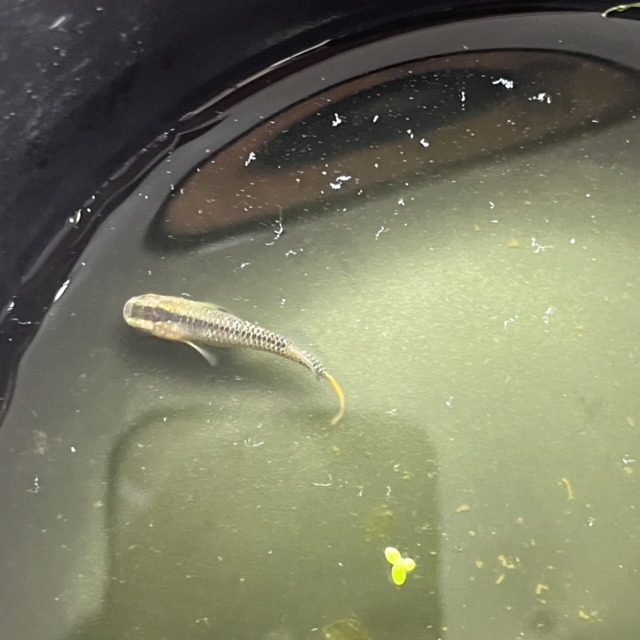In this article, I will discuss what to do if your medaka aren’t laying eggs and share some tricks to increase egg production. The conclusion is simple: as long as a sexually mature medaka (over 2 cm in length) is not sick, providing the following three essentials will almost certainly lead to spawning:
Lighting (at least 13 hours a day)
Temperature (20°C or higher, ideally over 25°C)
If these three conditions are met, it is almost certain that medaka will lay eggs. The individual difference is significant, but it is rare that they won’t lay eggs within a week to a month.
Reproductive ability is the most crucial function for living creatures. Medaka need to produce a large number of offspring to ensure survival, unlike humans. Therefore, if a medaka is not ill, it’s unlikely to be infertile.
If your medaka aren’t laying eggs, review the three basics above. This article assumes you’ve taken care of these basics and will introduce some tricks to further promote spawning. However, always ensure that food, lighting, and temperature are well managed.
Pay Attention to Food and Light if Your Medaka Aren’t Laying Eggs
If your medaka aren’t laying eggs, pay attention to their lighting and food. Firstly, medaka won’t lay eggs unless exposed to light for more than 12 hours a day, so keeping them in dark places can result in no eggs being laid.
Additionally, if medaka are malnourished, they will not lay eggs because females require a lot of protein and other nutrients to produce eggs. If they’re undernourished, they can’t produce eggs and won’t lay them.
Feed your medaka plenty of high-nutrition food until their bellies are full, which will increase the number of eggs they lay.
Simply providing more food than usual will work, but “saturation feeding” is recommended.
For a highly effective method to increase spawning, read about “saturation feeding” here.
Ensure That Medaka Really Aren’t Laying Eggs
Check your aquarium carefully to ensure that the medaka really aren’t laying eggs. They are prolific breeders and can easily multiply without you noticing.
In many cases, eggs are present but just hidden in the aquarium. Search thoroughly!
I once despaired when a medaka costing 1,000 yen didn’t lay eggs, but when I observed the aquarium closely, I found fry swimming around.
Medaka eggs are transparent and hard to see among plants or soil, unless you drain the water.
Females lay eggs on spawning beds, aquatic plants, and directly on the substrate. For clarity, it’s best to exclude plants and soil, and use only spawning beds, as professional breeders do.
Ensure Both Male and Female Medaka Are Present
Medaka won’t lay eggs without both male and female fish. It’s easy to distinguish them: males have longer pelvic fins and a notch in the dorsal fin, while females have shorter pelvic fins. Females have larger bellies and lighter colors, while males are darker, more active, and chase other fish.
However, it can be difficult to distinguish long-finned or shiny-type medaka by gender. Beginners may struggle to identify Real Longfin and other varieties. Even professionals cannot always accurately distinguish them, so consider changing pairs if necessary.
Situations Where No Eggs Seem to Be Laid
Here are some scenarios where medaka may not lay eggs at all:
Males Aggressively Chase Females
If males chase females aggressively, they may not recognize the females as mating partners, preventing egg-laying. Males will chase potential mates, but they do not attack aggressively.
If males aggressively attack females like bullying, it means no mating is happening, so no eggs will be laid.
If the environment is suitable, males will gradually stop chasing and swim peacefully with females. It’s usually a sudden change, so don’t worry too much.
If males keep chasing or females become clearly weak, separate them briefly or change pairs.
Females Have Small Bellies
Before laying eggs, females’ bellies will swell. If their bellies are slim like the males’, they won’t lay eggs. Overfeeding or a full stomach can also cause a swollen belly, but the shape is different.
In this case, increase the amount of food, feed them spawning-specific food, live food, or increase lighting.
How to Encourage Medaka That Aren’t Laying Eggs
Here’s how to encourage non-laying medaka to lay eggs:
Provide Lighting
Medaka won’t lay eggs unless exposed to light for over 12 hours. While biologically they can lay eggs with minimal light, providing strong light is still essential.
If your aquarium isn’t exposed to any sunlight, move it closer to a window.
Feed Them High-Protein Food in Abundance
As medaka won’t lay eggs if malnourished, provide high-nutrition food. Underweight females won’t lay many eggs, so feed them until their bellies are full.
Live foods like bloodworms and daphnia are considered best.
Frequent feeding of live foods helps boost egg-laying.
Note: when you first introduce them, too much food can cause water quality issues or digestive problems, possibly killing them. Feed sparingly for about a week, then gradually increase.
Prepared Food Is Also Fine

Commercially available medaka breeding food can be effective too. The most famous is Hikari’s Breeding Food, recognizable by its gold packaging.
After switching to this food, I noticed an increase in the number of females laying eggs within a few days. Now, I exclusively use this food, and none of my medaka have failed to lay eggs due to illness.
Feed them two to three times a day instead of just once.
When feeding, give small portions gradually using “saturation feeding” for better results. This significantly improved my medaka’s egg-laying.
Read more about saturation feeding here.
High-nutrition commercial feeds like Nichido’s High Grow are also available. If your medaka aren’t laying eggs, change their food and increase the amount.
Change the Water
External stimuli like water changes can trigger spawning. Sometimes they start laying eggs the day after changing the water. If they aren’t laying eggs, try changing the water.
Use a pipette to remove water from the bottom and top it up to stimulate spawning.
Use Water Conditioners
Water conditioners like Tetra Vital can encourage egg-laying. They contain essential vitamins and minerals, creating optimal water conditions.
Try conditioners specifically for medaka.
Move Them Outside
Personally, moving my indoor medaka outside was most effective. They began laying eggs immediately after being moved to an outdoor bi











No comments yet.